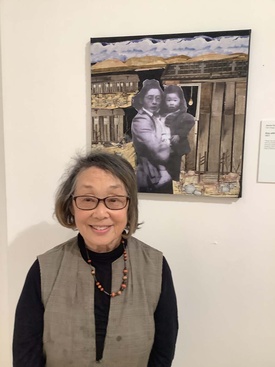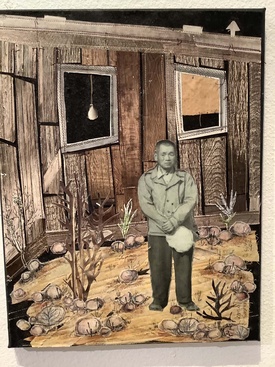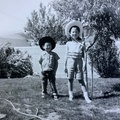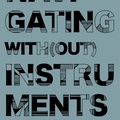She was the first baby born at the Topaz Concentration Camp in central Utah. The hospital was not completed yet, so her mother gave birth on a laundry room floor less than two weeks after their arrival in September 1942. A wooden food crate improvised for a crib. Her father was so grateful to the Nikkei doctor, Dr. Eugenia Fujita, that they named the baby after her.
Eugenia “Jeanie” Kashima began a series of Topaz collages during COVID isolation. Her mother, Amy Oishi Takaki, had passed away at age 104 in 2020. Kashima had created art quilts but wanted an artistic way to use the precious family photos taken in camp. So she began creating collages with family photos and artwork.
She started by enlarging the black-and-white photos that were only 2 x 3 inches. Kashima said, “I like the idea of gathering things and putting them together. I just love the process.” She added twigs and scraps of fabric to her collages.
Thomas and Amy Takaki and their young son, Glenn, had a big home in Berkeley, California before their forced relocation to Tanforan Race Track just south of San Francisco. After months at Tanforan, they were sent to Topaz on September 11 of that year. They were incarcerated at Topaz until 1945.
In the beginning, cameras were not allowed in the concentration camp. However, two uncles in the U.S. armed forces visited Topaz with their cameras and were allowed to take photos of relatives. Kashima feels lucky to have her baby photos and those of her family in camp.
Kashima, who took some art classes at San Francisco State University, created twelve Topaz collages from 2020 to 2022. Her Topaz Collages exhibit was on display January 21–May 27, 2023 at the Visions Museum of Textile Art in San Diego, California.
The Collages
Kashima created Panoramic View of Topaz (2022) because “I wanted a long shot of what the camp (looked like) so people who weren’t familiar with the camps could understand what the layout was. And this one shows all the barracks.”
The Topaz Concentration Camp, also known as Central Utah Relocation Center, had 42 blocks which housed over 8,000 people. Each block had 12 barracks. It was 16 miles from the town of Delta and 130 miles from Salt Lake City. Her family was in Block 7.
The most poignant collage is Laundry Room #4 (2021). This was the hardest collage for Kashima to create, since she wasn’t sure what the camp laundry rooms looked like. She realized the floor was concrete, when one of the Topaz internees remembered that water would puddle on the floor.
Kashima created an image with a deep laundry sink and rough barrack walls. Nearby is an image of a baby in a wooden crate, a reference to her birth, and crumpled fabric on the floor.
Baby Eugenia in Infant on the Bed (2021) stares directly at the viewer. A single light bulb dangles next to the baby. Her family was assigned a 20 ft. x 20 ft. barrack room. The room had army cots with a pot belly stove for warmth and one light bulb. Rough wooden planks covered the floor.
Kashima said, “This is where I learned how to crawl.”
Her collage Amy with Baby (2021) shows her mother, Amy Takaki, holding young Eugenia. Barracks and stark desert landscape are in the background. Kashima said, “You can see how barren it was—not a pleasant place to be.”
The image is one of the National Park Service trading cards for the Rosie the Riveter WWII Home Front National Historic Park in Richmond, California. On February 19, 2023, Kashima spoke at the Day of Remembrance program at the Rosie the Riveter museum, sponsored by the Contra Costa JACL.
Her Issei grandfather, Seizo Oishi, owned a large wholesale carnation nursery in Richmond. It was bewildering and painful to him that the United States government would put him and his family behind barbed wire. In the collage, Grandpa Oishi (2021), his face looks somber and sad. He stands amidst a rocky desert landscape near a barrack. A window shade is pulled up, revealing a single light bulb.
Kashima said, “That must have been so hard to leave his business.” When they finally returned to the nursery, it was in bad shape with cracked windows.
Kashima created the collage Family (2020) because she wanted to have one collage showing her whole family together. This piece shows her parents and grandfather with Eugenia and Glenn standing near the barracks, guard towers, barbed wire, and desert landscape.
She has only one photo of her father in camp. In Thomas Takaki (2021), her father is supervising the planting of thousands of trees and bushes at Topaz. He had studied landscape architecture at U.C. Berkeley. Though highly educated, he was unable to get any sort of important position due to discrimination since he was Japanese American. Kashima found this photo in the U.C. Berkeley archives.
Shortly after they left Topaz, her father passed away from cancer. Her mother became a widow with three young children.
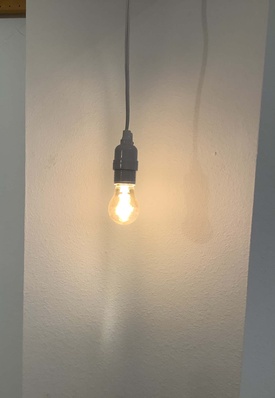
When Kashima returned to Topaz in April 2022, she had not been there for almost 80 years. She returned to Laundry Room #4, but found only a cement foundation. The trees and shrubs planted by her father and others had died. She found only greasewood and alkaline soil. In Eugenia (2022), an adult Kashima stands in front of the barren desert landscape.
Kashima hopes that her Topaz collage exhibit can travel to other museums. She is grateful to the Visions Museum of Textile Art for sponsoring her San Diego exhibit, which can be viewed on its website.
She wants to thank the Contra Costa JACL for inviting her to their 2023 Day of Remembrance program at the Rosie the Riveter museum.
Kashima is a longtime member of the Buddhist Temple of San Diego (BTSD) and a retired San Diego resource teacher. She has two children and four grandchildren. Her late husband was Tetsuyo Kashima, a lay minister for the BTSD. His father was a Buddhist minister. The Kashima family was also incarcerated at Topaz.
*An article about her Topaz collages appeared in the March 2023 edition of Wheel of Dharma, a publication of the Buddhist Churches of America. Her story “Topaz Birth” can be found on the Topaz Stories website.
© 2023 Edna Horiuchi


